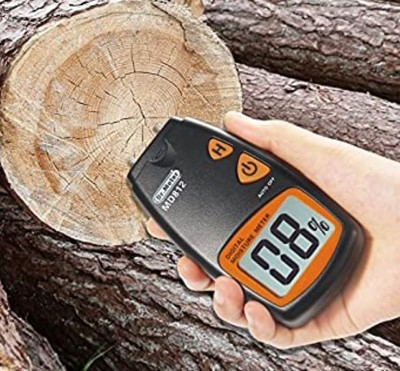- Metric Thread
- Metric Thread - Bolt Torque table
- Metric Thread - Pitch
- Metric Thread - Tap Drill table
- Metric Thread - Clearance Hole table
- Metric Fine Thread - Bolt Torque table
- Metric Fine Thread - Pitch
- Metric Fine Thread - Tap Drill table
- Metric Wrench Sizes
- Sheet Metal Screws Pilot Hole Sizes
- Cable Gland Sizes
- Trapezoidal Thread Sizes
- Cutting Metric Thread
- Inch Thread
- The Screw
- Drill correctly
- Which Dowel
- Materials
- Language
Wood weight

The weight of wood is often given in kg/m³. With this unit of measurement, it is quick and easy to calculate the weight of a tuned quantity of wood. It should be noted, however, that the weight of wood is very much dependent on the degree of dryness. The drier the wood, the lighter it becomes. The difference in weight between dry wood and freshly cut wood is very large here.
| Here is an example of beech wood: | |||
|
Degree of dryness - "Air dry Residual moisture approx. 12 - 20 % |
Degree of dryness - "freshly cut Residual moisture approx. 50 - 60 % |
||
| beech wood | 680 kg/m³ | 910 kg/m³ |
In this example, you can clearly see the difference in weight between dry and freshly cut wood. Please note that wood is a naturally grown raw material and weights here are approximate values.
In the table "Wood weight" below, you will find many types of wood in the overview and the weight.
Wood weight table
In the following table you will find the weight for the most known types of wood, with a water content of approx. 12 to 20% residual moisture. This is referred to as air-dried wood. The mentioned residual moisture is reached after approx. 2 years of storage in the open air. In order to calculate the weight of the wood, you need to know the exact amount of wood. For this purpose, the conversion below helps.
| Type of wood |
Degree of dryness - "Air dry Residual moisture approx. 12 - 20 %
weight in kg/m³ |
Degree of dryness - "freshly cut Residual moisture approx. 50 - 60 %
weight in kg/m³ |
||
|
Balsa |
130 | 260 | ||
| Poplar | 370 | 560 | ||
| Spruce | 420 | 680 | ||
| Fir | 460 | 750 | ||
| Pine | 490 | 860 | ||
| Alder | 530 | 710 | ||
| Larch | 550 | 850 | ||
| Douglas fir | 580 | 800 | ||
| Maple | 590 | 790 | ||
| Cherry | 600 | 810 | ||
| Birch | 630 | 830 | ||
| Walnut | 650 | 840 | ||
| Ash | 650 | 860 | ||
| Beech | 680 | 910 | ||
| Oak | 710 | 970 |
* All data without guarantee.
cubic meter / bulk cubic meter / solid cubic meter - conversion
In order to correctly calculate the weight of a quantity of wood, you need to convert to solid cubic meters. For this purpose, there is a rough conversion key, which facilitates the conversion. If you have determined the solid cubic meter quantity of wood, you can use the upper wood weight table to calculate the weight relatively accurately.
cubic meter (also called ster)
One cubic meter is a cube of sized wood, with an edge length of 1m x 1m x 1m.
Bulk cubic meter
In the trade of wood is often used the unit of measurement bulk cubic meter. This is one cubic meter of logs, loosely piled up. Here is much more air between the logs, which makes the conversion below clear.
Solid cubic meter
One solid cubic meter means one block of solid wood with an edge length of 1m x 1m x1m.
Conversion:
1 cubic meter = 0.7 solid cubic meter = 1.4 bulk cubic meter
1 solid cubic meter = 1.4 cubic meters = 2.3 bulk cubic meters
1 bulk cubic meter = 0.7 cubic meter = 0.4 solid cubic meter
Wood Moisture Firewood
Firewood ready for the stove should have a wood moisture content between 15% and 20%. Firewood with this residual moisture has a high calorific value of approximately 4 kW/kg and burns relatively low in emissions. With proper storage, beech and spruce wood can reach a wood moisture content of under 20% in less than a year.
What happens when you burn wet wood?
The wood would burn very poorly, hiss, and smoke. The heating value would be very low. Additionally, burning wet wood produces significantly more soot, which can lead to heavy sooting of the combustion chamber (window) and the chimney. Burning wet wood is strongly discouraged!
Measuring wood moisture

Using a wood moisture meter, you can easily and quickly measure the moisture content. Simply insert the measuring probes into the wood, and the meter will immediately display the moisture level. It's advisable to repeat the measurement on several pieces of wood to obtain a relatively accurate reading. With the measured value, you can also more precisely determine the total weight of the wood and calculate accordingly.
The following topics may also be of interest to you:
